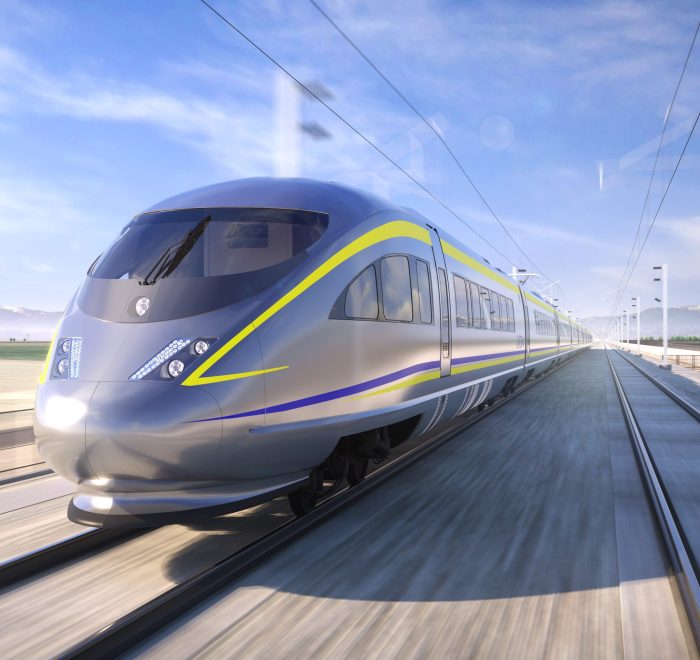Can the state complete its Los Angeles-to-San Francisco bullet train project faster? The answer is yes, with stronger cooperation and buy-in from state and federal leaders. That was the conclusion of a panel hosted by Streetsblog this week on how to accelerate the pace of construction on California High-Speed Rail.
The panel was hosted by Streetsblog San Francisco editor Roger Rudick and sustainable transportation advocate Carter Lavin, and included Boris Lipkin, the Northern California Regional Director of the California High-Speed Rail Authority, and Eric Eidlin, Station Planning Manager for the City of San Jose. KTLA covered the discussion. Look for a future podcast from Talking Headways, which recorded audio from the talk, or watch the video.
Rudick kicked off the discussion by comparing the high speed rail program to other large projects the U.S. has experience with.
In 1962, President Kennedy said, ‘We will go to the moon before the decade is out.’ Six years later, humans traveled to the moon, and a year after that they walked on the moon. The Transcontinental Railroad was built in six years. And they started construction during the Civil War - I would say that’s a pretty big socio-economic challenge for starting a big project.
Lipkin talked about the on-the-ground realities of the complex project, from buying land to completing environmental analyses to moving utilities. He also has to coordinate multiple state and local agencies and construction companies. All of these take money, effort, and a lot of time to complete.
Despite these challenges, though, the project is making steady forward progress. Lipkin's view is that shortening the timeline would require more simultaneous construction than existing construction companies could handle.
“We’re talking about some pretty big, big numbers. It’s a question of can that level of construction happen in that kind of time frame?” he said.
But Lavin said there are lots of people who would be happy to come to California to take on those jobs.
Funding
Money remains an issue, and the lack of champions among state and federal leaders has made this a hard problem to solve.
Lipkin pointed out that, "out of the funding that we have so far, about 85 percent of that has come from the State of California, and fifteen percent has come from the federal government. When we did the highway system over thirty, forty years of highway construction, those ratios were reversed. So the federal government was eighty to ninety percent, and state governments supported it with about ten percent of the needed funding.”
Rudick had him repeat that crucial bit of data. The interstate highway system was so important strategically to the country that the federal government footed most of the bill. That's the kind of urgency on the part of leadership that's missing from the high-speed rail picture, and without it California is left struggling to figure out how to pay.
"California is doing its best to cover the costs, and Lipkin believes the project can be completed with the state footing the majority of the bill. But if Californians want the High-Speed Rail Program completed sooner, the federal government would have to chip in significantly more," according to KTLA's coverage.
Lavin pointed out that “the number one source of carbon emissions in California is cars. Highway 5 is crowded with travelers. So a Central Valley rail line will get many of those cars off the road. When we can connect tens of millions of people with high-speed rail - when we’re connecting the 6.5 million people who live in the Central Valley with high-speed rail - this will offset so much carbon."
Lavin urged advocates for high-speed rail to "think of it as more than just a transportation undertaking."
“I think most Californians can barely afford rent. I think most Californians are worried about putting food on the table, most Californians are struggling. And I think the high-speed rail is going to help them. When we talk about job access, about having a hard time affording rent - frankly speaking, the high-speed rail project is, in a sense, one of California’s biggest affordable housing infrastructures going on.”
Several times he urged listeners and supporters of the project to call their local representatives and urge them to support the project. "Google Governor Newsom's phone number," he said. "It's a 916 number. Call him up and tell him to advocate for more federal funding, and to finish the project sooner."
The longer the project takes to complete, the more expensive it will become, but whether or not the project has the support of everyone in the state, it has officially reached the “point of no return,” according to Lipkin.
One way or the other, the high-speed trains are coming to California. It's simply a question of how long it's going to take to get it running.






